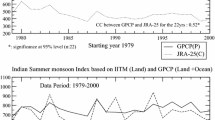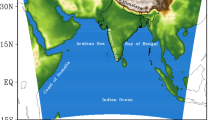Abstract
It has been found in observation that there are different types of influences of El Nino Southern Oscillation (ENSO) on the South Asian Monsoon (SAM). A correct description and representation of these teleconnections is critical for climate models to simulate and predict SAM. In this study, we examine these teleconnections in NCAR CAM4 and CCSM4 models, including the strength and weakness of these models in preserving different types of ENSO–SAM relationships. By using observational and simulation dataset, the composite analysis, based on specific selection criteria, is performed for both SAM rainfall and the eastern equatorial Pacific sea surface temperature (SST) anomalies. Anomalous SAM rainfall is characterized in three different types i.e. the indirect influence of the SST anomalies of preceding winter (DJF-only), direct influence of the SST anomalies of concurrent summer (JJAS-only) and the combined influence of both preceding winter and concurrent summer (DJF&JJAS). The analysis reveals that CAM4 uncoupled simulation can reasonably well reproduce the anomalous SAM rainfall in DJF-only and DJF&JJAS types whereas the model fails to simulate the anomalous rainfall in the JJAS-only type. The better performance of CAM4, particularly in DJF&JJAS type, comes from its realistic simulation of moisture content and thermal contrast. Its failure to preserve the ENSO–SAM relationship of JJAS-only type is due to the absence of ENSO induced warming in Northern Indian Ocean via atmospheric circulation which is indirectly linked to the lack of air–sea coupling. The role of Indian Ocean in controlling the ENSO–SAM teleconnections of the DJF&JJAS type is further investigated using CAM4 sensitivity experiments. It is found that in absence of Indian Ocean SST, the anomalous SAM summer rainfall suppresses in the DJF&JJAS type, suggesting the important modulation by Indian Ocean SST probably through the preceding winter equatorial Pacific SST forcing and the atmospheric circulations. On the other hand, CCSM4 shows large systematical errors in DJF-only and DJF&JJAS types and reproduce weak anomalous SAM rainfall. The failure of CCSM4 in simulating DJF-only and DJF&JJAS types is found mainly due to the errors in its SST simulation. The JJAS-only type is better reproduced in the CCSM4 simulation as compared to CAM4 and observation composites. Strong convergence over the SAM region which intensifies the anomalous SAM is seen to be responsible for its better simulation in this type. It is found that the atmospheric circulations in CCSM4 contribute more than the thermal contrast in modulating the intensity of anomalous rainfall in JJAS-only type. This study suggests that, although air–sea coupling is important for better SAM simulation and its relationship with ENSO, the SST bias in coupled model can significantly degrade ENSO–SAM relationship.













Similar content being viewed by others
References
Achuthavarier D, Krishnamurthy V, Kirtman BP, Huang B (2012) Role of the Indian Ocean in the ENSO–Indian summer monsoon teleconnection in the NCEP climate forecast system. J Clim 25(7):2490–2508
Anderson J, Hoar T, Raeder K, Liu H, Collins N, Torn R, Avellano A (2009) The data assimilation research testbed: a community facility. Bull Am Meteorol Soc 90:1283–1296
Ashok K, Guan Z, Yamagata T (2001) Impact of the Indian Ocean Dipole on the relationship between the Indian monsoon rainfall and ENSO. Geophys Res Lett 28:4499–4502
Bollasina M, Nigam S (2009) Indian Ocean SST, evaporation, and precipitation during the South Asian summer monsoon in IPCC AR4 coupled simulations. Clim Dyn 33:1017–1032. doi:10.1007/s00382-008-0477-4
Boschat G, Terray P, Masson S (2012) Robustness of SST teleconnections and precursory patterns associated with the Indian summer monsoon. Clim Dyn 38(11–12):2143–2165
Chang EC, Yeh SW, Hong SY, Wu R (2011) The role of air–sea interaction over the Indian Ocean in the in-phase transition from the Indian summer monsoon to the Australian boreal winter monsoon. J Geophys Res 116:D01107
Chengfeng L, Yanai M (1996) The onset and interannual variability of the Asian summer monsoon in relation to land–sea thermal contrast. J Clim 9:358–375
Collins WD et al (2006a) The Community Climate System Model version 3 (CCSM3). J Clim 19:2122–2143
Collins WD et al (2006b) The formulation and atmospheric simulation of the Community Atmosphere Model: CAM3. J Clim 19:2144–2161
Fu C, Fletcher JO (1985) The relationship between Tibet-tropical ocean thermal contrast and interannual variability of Indian monsoon rainfall. J Clim Appl Meteorol 24:841–847
Gent P, Danabasoglu G, Donner L, Holland M, Hunke E, Jayne S, Lawrence D, Neale R, Rasch P, Vertenstein M, Worley P, Yang ZL, Zhang M (2011) The Community Climate System Model Version 4. J Clim 24:4973–4991
Hoffmann RN, Kalnay E (1983) Lagged average forecasting, an alternative to Monte Carlo forecasting. Tellus 35A:100–118
Hunke EC, Lipscomb WH (2008) CICE: the Los Alamos sea ice model user’s manual, version 4. Los Alamos National Laboratory technical report LA-CC-06-012
Islam S, Tang Y, Jackson P (2013) Asian monsoon simulations by Community Climate Models CAM4 and CCSM4. Clim Dyn 41(9–10):2617–2642. doi:10.1007/s00382-013-1752-6
Islam S, Tang Y, Jackson P (2015) Optimal error growth of South Asian monsoon forecast associated with the uncertainties in the sea surface temperature. Clim Dyn. doi:10.1007/s00382-015-2686-y
Ju J, Slingo J (1995) The Asian summer monsoon and ENSO. Q J R Meteorol Soc 121:1133–1168
Kawamura R (1998) A possible mechanism of the Asian summer monsoon–ENSO coupling. J Meteorol Soc Jpn 76:1009–1027
Kiehl JT, Gent PR (2004) The Community Climate System Model, version 2. J Clim 17:3666–3682
Kistler R, Kalnay E, Collins W et al (2001) The NCEP-NCAR 50-year reanalysis: monthly means CD-ROM and documentation. AMS Bull 82:247–267
Meehl GA (1994) Influence of the land surface in the Asian summer monsoon: internal conditions versus internal feedback. J Clim 7:1033–1049
Mooley DA, Parthasarathy B (1984) Fluctuations in All-India summer monsoon rainfall during 1871–1978. Clim Change 6:287–301
Neale RB, Jochum M, Richter JH (2008) The impact of convection on ENSO: from a delayed oscillator to a series of events. J Clim 21:5904–5924
Neale RB et al (2010) Description of the NCAR Community Atmosphere Model (CAM 4.0). NCAR technical note NCAR/TN-485 + STR, National Center for Atmospheric Research, Boulder, CO
Palmer TN, Brankovic C, Viterbo P, Miller MJ (1992) Modelling interannual variations of summer monsoons. J Clim 5:399–417
Rasmusson EM, Carpenter TH (1983) The relationship between eastern equatorial Pacific sea surface temperature and surface wind fields associated with the southern oscillation/El Niño. Mon Weather Rev 111:517–528
Reynolds RW, Rayner NA, Smith TM, Stokes DC, Wang W (2002) An improved in situ and satellite SST analysis for climate. J Clim 15:1609–1625
Richter J, Rasch P (2008) Effects of convective momentum transport on the atmospheric circulation in the Community Atmosphere Model, version 3. J Clim 21:1487–1499
Ropelewski CF, Halpert MS (1987) Global and regional scale precipitation patterns associated with the El Nino/southern oscillation. Mon Weather Rev 115:1606–1626
Saji NH, Goswami BN, Vinayachandran PN, Yamagata T (1999) A dipole mode in the tropical Indian Ocean. Nature 401:360–363
Shukla J (1987) Interannual variability of monsoons. In: Fein JS, Stephens PL (eds) Monsoons. Wiley, New York, pp 399–463
Shukla J, Paolino DA (1983) The southern oscillation and long-range forecasting of the summer monsoon rainfall over India. Mon Weather Rev 111:1830–1837
Shukla J, Wallace JM (1983) Numerical simulation of the atmospheric response to equatorial Pacific sea surface temperature anomalies. J Atmos Sci 40:1613–1630
Sikka DR (1980) Some aspects of the large scale fluctuations of summer monsoon rainfall over India in relation to fluctuations in the planetary and regional scale circulation parameters. Proc Indian Acad Sci (Earth Planet Sci) 89(2):179–195
Smith RD, Gent P (2002) Reference manual for the Parallel Ocean Program (POP). Los Alamos Unclassified Report LA-UR-02-2484
Smith RD, Kortas S (1995) Curvilinear coordinates for global ocean models. Los Alamos Unclassified Report LA-UR-95-1146
Soman MK, Slingo J (1997) Sensitivity of the Asian summer monsoon to aspects of sea-surface-temperature anomalies in the tropical Pacific Ocean. Q J R Meteorol Soc 123:309–336
Sperber KR, Palmer TN (1996) Interannual tropical rainfall variability in general circulation model simulations associated with the Atmospheric Model Intercomparison Project. J Clim 9:2727–2750
Terray P, Delecluse P, Labattu S, Terray L (2003) Sea surface temperature associations with the late Indian summer monsoon. Clim Dyn 21:593–618
Terray P, Dominiak S, Delecluse P (2005) Role of the southern Indian Ocean in the transitions of the monsoon–ENSO system during recent decades. Clim Dyn 24:169–195
Vavrus S, Waliser D (2008) An improved parameterization for simulating Arctic cloud amount in the CCSM3 climate model. J Clim 21:5673–5687
Walker GT (1924) Correlation in seasonal variations of weather, IV, a further study of world weather. Mem Indian Meteorol Dept 24:275–332
Wang B, Kang IS, Li JY (2004) Ensemble simulation of Asian-Australian monsoon variability by 11 AGCMs. J Clim 17:803–818
Webster PJ (1987) The elementary monsoon. In: Fein JS, Stephens PL (eds) Monsoons. Wiley, New York, pp 3–32
Webster PJ, Yang S (1992) Monsoon and ENSO: selectively interactive systems. Q J R Meteorol Soc 118:877–926
Webster PJ, Moore A, Loschnigg J, Leban M (1999) Coupled dynamics in the Indian Ocean during 1997–1998. Nature 401:356–360
Wu R, Kirtman B (2004) Impacts of the Indian Ocean on the Indian Summer Monsoon–ENSO relationship. J Clim 17:3037–3054
Wu R, Chen JL, Chen W (2012) Different types of ENSO influences on the Indian summer monsoon variability. J Clim 25:903–920
Xie P, Arkin PA (1997) Global precipitation: a 17-year monthly analysis based on gauge observations, satellite estimates, and numerical model outputs. Bull Am Meteorol Soc 78:2539–2558
Yang S, Lau K-M (1998) Influences of sea surface temperature and ground wetness on Asian summer monsoon. J Clim 11:3230–3246
Yang S, Lau KM, Yoo SH, Kinter JL, Miyakoda K, Ho CH (2004) Upstream subtropical signals preceding the Asian summer monsoon circulation. J Clim 17:4213–4229
Yoo SH, Yang S, Ho CH (2006) Variability of the Indian Ocean sea surface temperature and its impacts on Asian-Australian monsoon climate. J Geophys Res 111:D03108. doi:10.1029/2005JD006001
Young JA (1987) Physics of monsoons: the current view. In: Fein JS, Stephens PL (eds) Monsoons. John Wiley, New York, pp 211–243
Zhu YL, Houghton DD (1996) The impact of Indian Ocean SST on the large-scale Asian summer monsoon and the hydrological cycle. Int J Climatol 16:617–632
Acknowledgments
This work is supported by Natural Sciences and Engineering Research Council (NSERC) of Canada Discovery Grant to Y. Tang. The authors are thankful to NCAR for providing models and their input data sets.
Author information
Authors and Affiliations
Corresponding author
Rights and permissions
About this article
Cite this article
Islam, S., Tang, Y. Simulation of different types of ENSO impacts on South Asian Monsoon in CCSM4. Clim Dyn 48, 893–911 (2017). https://doi.org/10.1007/s00382-016-3117-4
Received:
Accepted:
Published:
Issue Date:
DOI: https://doi.org/10.1007/s00382-016-3117-4




